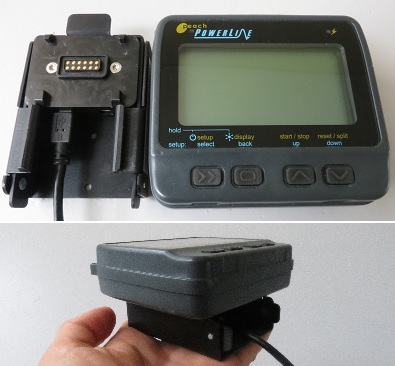Logger features
Display. By default, the display shows speed, rating, distance per stroke and average crew power. The LCD display has excellent visibility across a wide range of lighting conditions, including direct sunlight. A backlight can be turned on in very low light levels by holding down the display button.
Data logging. All channels are sampled 50 times per second (50Hz). The logger's large storage capacity can hold 4 hours worth of data from an 8+ (with 20 channels) or 10 hours from a 1x (with 8 channels). In addition, the logger stores all data generated each stroke (e.g. rating, power) and stopwatch data. The logger normally logs all the time it is powered up but, to preserve memory, this can be switched to record only when rowing or only when the stopwatch is running. When the memory is full, it carries on recording, overwriting the oldest data.
Quality case. The logger's case measures 103x72x30mm and is machined from solid aluminium. It is sealed for complete submersion. It is not buoyant, but features an attachment point for a lanyard.
Battery life. Over half of the logger is battery! Its large capacity enables around 4 hours of use with an 8+. A built-in fast charger enables a full recharge in less than 2 hours fom a 12V supply. It intelligently switches to a slow charge during conditions that may harm the battery - i.e. extreme cold or heat.

Download. After a session, the logger is placed on a download cradle with a fast USB connection to a PC. This enables 2 hours of data to be downloaded in less than 10 minutes.
Communications. In addition to its connection to the sensors, the logger features two other communications links:
- Fast telemetry - sends the full data to a PC in real-time either via a radio (for use by coaches in launches) or cable (e.g. for use in a rowing tank);
- Video synchronisation - communicates with a video camera to align frame numbers precisely with the data.
Setup. All setup parameters are available through a simple menu system on the display. This provide access to:
- Time, date and session number
- Contrast settings for the display
- Stopwatch and logging characteristics
- Impeller scaling and other calibration factors
Diagnostics. All sensor readings can be viewed in real-time on the display, so correct operation can be checked without connection to a PC. This mechanism is used for confirming the position of various sensors during installation (e.g. oarlock angle, seat position).
Future development. A range of options are being considered for real-time display within the boat - an interesting problem in 'man-machine-interfaces'! Future releases of software for the logger will be available as customer upgrades.